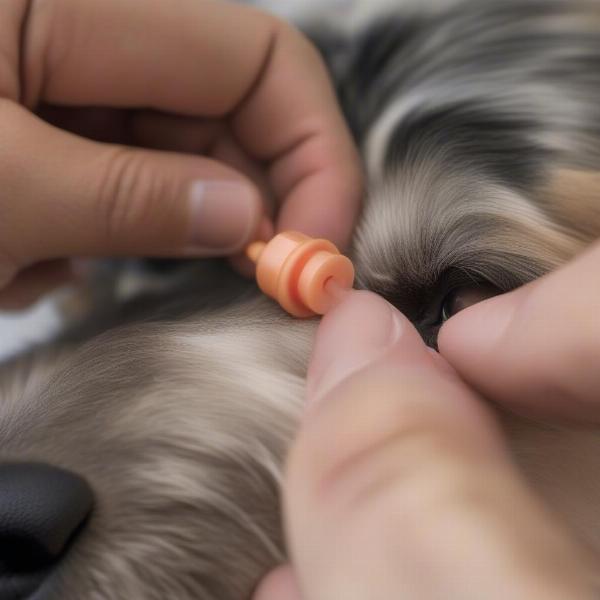Dog ear plugs for noise are becoming increasingly popular among pet owners looking to protect their furry friends from loud, potentially harmful sounds. Whether it’s fireworks, thunderstorms, or construction noise, these small but mighty devices can offer significant comfort and reduce anxiety in dogs. This guide will delve into the benefits, types, and usage of dog ear plugs, helping you decide if they’re the right choice for your canine companion.
Understanding the Need for Dog Ear Plugs
Many dogs experience significant distress from loud noises. Unlike humans, their hearing is much more acute, making them particularly sensitive to sounds we might find merely annoying. This sensitivity can manifest as trembling, hiding, excessive barking, pacing, or even destructive behavior. Dog ear plugs offer a practical solution by dampening the intensity of these noises, creating a calmer environment for your dog. Do you find your dog exhibiting signs of anxiety during loud events? If so, ear plugs might be a viable option to consider.
Types of Dog Ear Plugs
There are several types of dog ear plugs available, each designed with specific features and benefits.
- Foam Ear Plugs: These are typically disposable and offer a good level of noise reduction. They are affordable and readily available. However, they may not be the most comfortable for long-term wear.
- Silicone Ear Plugs: Reusable and moldable, silicone ear plugs offer a snug fit and can be custom-shaped to your dog’s ears. They are more durable than foam but require more care and cleaning.
- Custom-Molded Ear Plugs: These are the most expensive option but offer the best fit and noise reduction. They are made by a veterinarian or specialist and are specifically designed for your dog’s ear canal.
How to Use Dog Ear Plugs
 Correctly inserting dog ear plugs
Correctly inserting dog ear plugs
Introducing your dog to ear plugs requires patience and positive reinforcement. Start by letting your dog sniff and investigate the ear plugs. Then, gently insert the plugs into the ear canal, ensuring they fit snugly but not too tightly. Reward your dog with treats and praise to create a positive association with the ear plugs. Don’t force the plugs if your dog resists. ear protectors for dogs can be a good alternative for some dogs.
Benefits of Using Dog Ear Plugs
- Reduced Anxiety: The primary benefit is the reduction of noise-induced anxiety. This can lead to a calmer and more relaxed dog during stressful situations.
- Hearing Protection: Prolonged exposure to loud noises can damage a dog’s hearing. Ear plugs can help protect their sensitive ears from permanent harm.
- Improved Behavior: By reducing anxiety, ear plugs can also help to minimize unwanted behaviors like excessive barking, destructive chewing, and pacing.
- Travel Comfort: Ear plugs can make traveling more comfortable for dogs, especially during flights or car rides.
Choosing the Right Dog Ear Plugs
Consider your dog’s size, breed, and temperament when choosing ear plugs. If your dog has any existing ear conditions, consult with your veterinarian before using ear plugs. For dogs with floppy ears, you might also consider dog ear mufflers or dog earmuffs.
Conclusion
Dog ear plugs for noise can be a valuable tool for managing noise-related anxiety and protecting your dog’s hearing. By carefully choosing the right type of ear plugs and introducing them properly, you can help your dog feel more comfortable and secure during loud events. Remember to always prioritize your dog’s comfort and well-being.
FAQ
- Are dog ear plugs safe? Yes, when used correctly, dog ear plugs are generally safe. However, it’s crucial to choose the appropriate size and type and to monitor your dog for any signs of discomfort.
- Can my dog still hear with ear plugs in? Yes, ear plugs reduce the intensity of noise but don’t completely block all sound. Your dog will still be able to hear, but at a more manageable level.
- How do I clean dog ear plugs? Follow the manufacturer’s instructions for cleaning. Silicone plugs can be washed with soap and water, while foam plugs are typically disposable.
- What if my dog doesn’t tolerate ear plugs? If your dog resists or shows signs of distress, do not force the ear plugs. Explore alternative options like creating a quiet space or using calming aids. You might find solutions for your dog’s howling at night at dog is howling at night.
- Can I use human ear plugs on my dog? No, it’s not recommended to use human ear plugs on dogs. They are not designed for a dog’s ear canal and could cause discomfort or damage.
- How long can my dog wear ear plugs? Follow the manufacturer’s guidelines. Some ear plugs are designed for longer wear than others.
- Are there any side effects of using dog ear plugs? Some dogs may experience minor irritation or discomfort initially. Monitor your dog closely and consult your vet if any issues arise.
Suggested Further Reading
If you’re planning a New Year’s getaway with your furry friend, check out our guide on dog friendly new year hotel breaks with entertainment 2023.
About ILM Dog
ILM Dog is your trusted international resource for all things canine. We offer expert guidance on dog breeds, health and medical care, training and behavior, nutrition, grooming, and finding the right products and accessories for your beloved companion. Whether you’re a seasoned dog owner or just starting your journey, our goal is to empower you with the knowledge and resources you need to provide the best possible care for your furry friend. For inquiries regarding dog ear plugs and other pet care solutions, feel free to contact us via email at [email protected] or call us at +44 20-3965-8624.